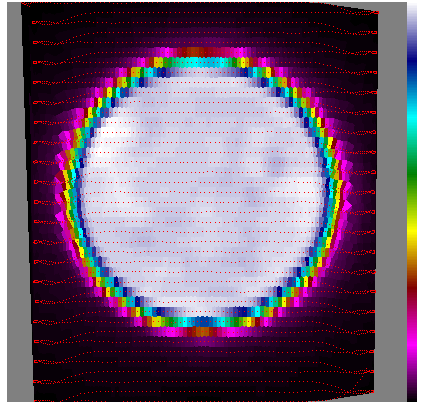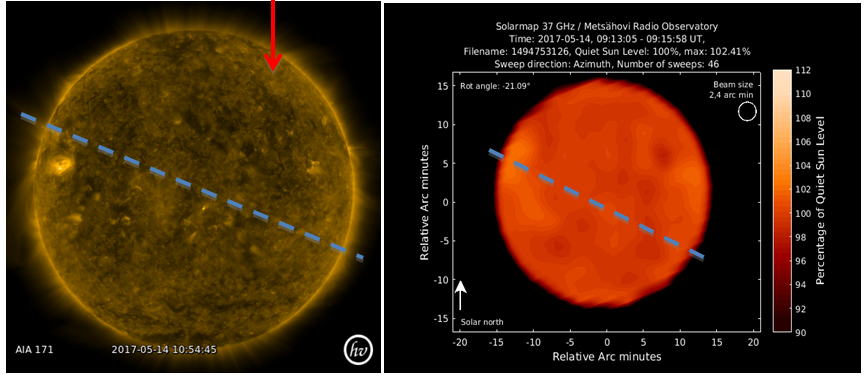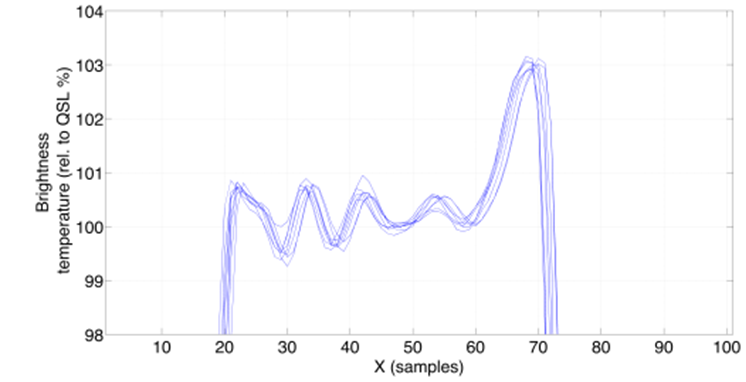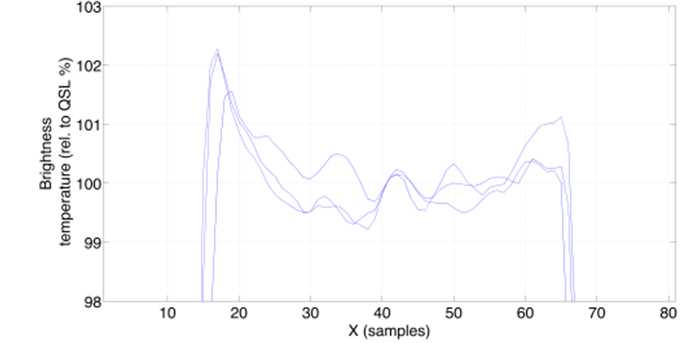eISSN: 2576-4543


Mini Review Volume 2 Issue 1
Mets
Correspondence: Juha Kallunki, Mets, Tel 358294424852
Received: December 20, 2017 | Published: January 2, 2018
Citation: Kallunki J. Preliminary studies of solar limb brightening at 8mm. Phys Astron Int J. 2018;2(1):1-3. DOI: 10.15406/paij.2018.02.00041
The investigation of the solar limb brightening can give information about various atmospheric structures of the Sun. In this study, preliminary investigations are made at the millimeter wavelength region. Data were obtained from Metsähovi Radio Observatory, Aalto University. The solar radio maps at 8 mm were used for the analysis. Data were only collected from the days of the low solar activity. We found limb brightening between 0.5 and 3 percent at the intermediate regions of the Sun. Our results are consistent with earlier reported results. There is no unambiguous explanation for the limb brightening, but spicules might be one possible source at higher radio frequencies. Also, the possible artificial effects are discussed.
Keywords: limb brightening, solar chromospheres, solar activity
The solar limb brightening has also been earlier studied in various microwave frequencies1–4 and also in Extreme Ultraviolet (EUV) region.5,6 The observations of solar limb brightening have highly variations and sometimes they have given even contradictory results. Several authors have reported the absence of limb brightening (such as7) at 35 GHz. This study focuses on studying limb brightening at 8 mm. Many of these previous studies have made at 17 GHz.1,4 Theoretical models8 predict the solar brightening is caused by the temperature gradient of the solar atmosphere. We only want to study the limb brightening at the intermediate regions of the Sun. Spicules (or jets) and facula features have been assumed to be the major contributor for the limb brightening at high radio frequencies. Spicules are chromospheric features that their role is probably important in high radio frequencies. A single spicule can reach 3,000-10,000km altitude above the solar photosphere. Faculae are photospheric feature1 such that their contribution is probably decreases at higher radio frequencies. Earlier studies with similar observing frequency have reported varying result: 3-10%,3 <1%3 and <1.5%.2 For this study, we only selected days with low-level of solar activity. Thus the solar activity does not affect to the observations and results. This is the major (low-level solar activity) difference to the previous studies on the same wavelength regimes.
Totally 19 solar radio maps from three different days (July 23, 2008, September 17, 2009 and May 14, 2017) were selected for the analysis. Observations were carried out using 13.7-meter Cassegrain type radio telescope, operated by Metsähovi Radio Observatory, Aalto University. The beam size of the telescope is 2.4 arc min and the noise temperature of the 8 mm receiver is approximately 280K. The telescope has high surface accuracy (0.1mm rms). The antenna provides solar radio maps, which were used in this study.9,10 Figure 1 shows the principle of the scanning method. The red points represent each individual measurement points. The time span between two consecutive solar radio maps is around 120 seconds at fastest. The maps can be measured with various scanning sweep numbers (default is 40). The dense sweep number makes possible to study more carefully features close to the solar limb, but span between two consecutive solar radio maps is then longer. For this analysis, we only selected the middle sweep (marked with red arrow in Figure 1) of each map. In Figure 2 one solar radio map from May 17, 2017 is presented. In addition, EUV images at wavelength 171Å recorded on the same day are presented. Solar Dynamic Observatory (SDO)/Atmospheric Imaging Assembly (AIA) provide continuous full-disk observations of the solar chromosphere and corona in seven EUV channels. These channels correspond temperature range between 20, 000K and 20, 000, 000K.EUV image, as well as radio map clearly shows that the general solar activity level is rather low in those selected days. The blue dashed lines in both plots indicate the solar map scanning direction.

Figure 1 The principle of the solar radio map using scanning method. The red arrow indicates the direction of sweeping, which was selected for the solar limb brightening analysis. The map is not rotated towards the solar north. A full-disc solar radio map consists of 40 x 100 data points.

Figure 2 Solar Dynamic Observatory (SDO) Atmospheric Imaging Assembly (AIA) 173Å image (left) has taken on May 17, 2017.11 Solar radio map (right) at 8 mm was observed on May 17, 2017. The blue dashed lines indicate the sweeps, which were taken to the limb brightening analysis.
Each observed scan showed clear limb brightening has effect on limb ranged between 0.5 and 3 percent of solar disk above the quiet Sun level (QSL). In Figure 3, the conducted observations are presented. The results are consistent with earlier results (such as2 and3) even if they conducted analysis over the days with the high-level of solar activity. The used instrument can cause artificial limb brightening, and also, darkening. Telescope’s side lobes are one possible candidate for the artificial limb brightening. The side lobes of the Metsähovi’s 13.7-metre dish are so small that this can be excluded. Also the prevailing weather conditions might cause something peculiar effects. All the solar maps included in this study were observed during the good weather conditions (clear sky without any clouds). In addition, all the observations were conducted at relatively high elevations (>20°). Low observation elevations might cause some artificial elements as well. The atmosphere at lower elevations is thicker and this can cause some aberrations. This is just a presumption.11,12



Figure 3 On upper left panel: three middle sweeps on July 23, 2008 from three different solar radio maps. On upper right panel: eight middle sweeps on September 17, 2009. On lower panel: eight middle sweeps on May 17, 2017. 100% indicates the quiet Sun level (QSL). QSL temperature at 8 mm is 8200 K±500K.11
The investigation of the solar limb brightening can give information about the atmospheric structures of the Sun, as well as it makes possible to study solar irradiance and solar diameter variations. In this study, we detected solar limb brightening between 0.5 and 3 percent. We had limited samples of suitable observation days, thus we only wanted to select days without any activity. Nevertheless we get the clear evidences of limb brightening and they are consistent with earlier results. We would like to continue this work in the future and collect more suitable data. Also it would be useful to study limb brightening in the polar and equator regions. In addition, it would be promising to do the observations in different stages of the solar cycle, again. For this knowledge, the spicules are the most obvious component, which affect to the limb brightening at millimeter wavelengths. Another features, which might contribute are the quiet Sun jets.
Helioviewer.org is part of the Helioviewer Project, an open-source project for the visualization of solar and heliospheric data. The Helioviewer Project is funded by ESA and NASA. The AIA data were made available courtesy of NASA/SDO and the AIA science team.
Author declares there is no conflict of interest.

©2018 Kallunki. This is an open access article distributed under the terms of the, which permits unrestricted use, distribution, and build upon your work non-commercially.